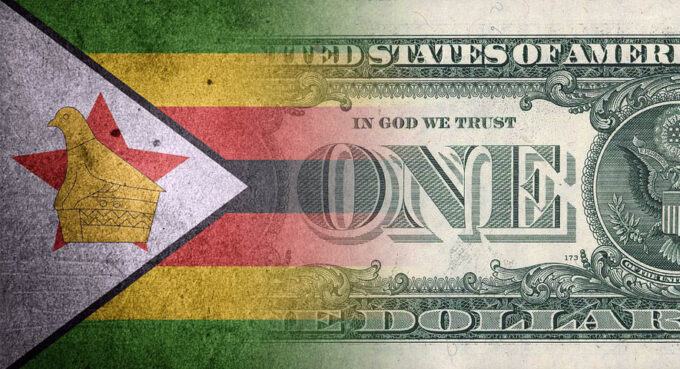
Victor Bhoroma THE Zimbabwean government has announced measures to promote the wider use of the domestic currency (the Zimbabwean dollar) in a last-ditch effort to save it from the re-dollarisation onslaught.
Part of the measures now compels businesses and individuals to pay customs and import duties in local currency using the Interbank Rate, which is based on the willing-buyer willing-seller (WBWS) model.
This foreign exchange rate changes daily and this means that duty will be adjusted frequently. Currently, there are at least five exchange rates that prevail in the Zimbabwean economy with the central bank pegged auction (Official) Rate at US$1:ZW$173.27, the central bank approved Interbank Rate (ZW$277,03), the Zimbabweanan dollar cash rate (ZW$360), the parallel market rate (ZW$430) and the electronic money rate used on card payments (ZW$450).
Other exchange rates also apply on mobile money and exchanging foreign currency in local Foreign Currency Accounts (FCA) to hard currency.
The disparities across these various exchange rates mean that the market has huge arbitrage opportunities on the pricing of various commodities and rice stability remains a dream.
Dedollarisation attempt In February 2019, the government relaunched the Zimbabwean dollar (monocurrency) and banned the use of multiple currencies through Statutory Instrument (SI) 142 of 2019.
It only took one year for the government to reverse the ban with the promulgation of SI 85 of 2020, which allowed consumers to legally pay for goods and services using foreign currency.
Other regulations (SI 185 of 2020) later followed to compel local businesses and persons to price their goods and services using the central bank determined foreign exchange rates. What followed afterwards was a rapid decline of the productivity because of a combination of factors coalesced around high inflation, exchange rate volatility and foreign currency shortages.
- Chamisa under fire over US$120K donation
- Mavhunga puts DeMbare into Chibuku quarterfinals
- Pension funds bet on Cabora Bassa oilfields
- Councils defy govt fire tender directive
Keep Reading
Economic output declined from 4% growth realised in 2018 to -6.5% recorded in 2019 and -6.2%, according to official figures from treasury.
Annual inflation raced from 57% in January to 521% recorded in December 2019.
Tax revenues plummeted from US$5,237 billion collected in 2018 to US$2,691 billion collected in 2019.
Inflation consumed household incomes, pension funds and corporate incomes with the latter partially resorting to retrenchments to stay afloat.
The World Bank estimates that extreme poverty cases in Zimbabwe increased from 4,7 million in 2018 to 6,6 million people in 2019 and 7,9 million in 2020.
Covid-19 and droughts exacerbated the poverty levels.
With skyrocketing inflation and devaluation of the domestic currency, the writing was always on the wall.
The de-dollarisation path went off rails soon after its launch due to absence of various economic fundamentals that support the stability of a fiat currency, such as, foreign reserves, low levels of inflation, market confidence, sustainable fiscal budget, and central bank monetary policy independence from political interference.
There are various elements that destroyed confidence in the domestic currency and made de-dollarisation an uphill task.
These include:
Political will on de-dollarisation plan
Apart from a leaked de-dollarisation roadmap document, Zimbabwe did not implement a long-term plan (5–10-year policy) of how to de-dollarise the local economy.
The plan should have included institutional reforms at the central bank to ensure autonomy from political interference and notable milestones on building foreign currency reserves, implementing a managed floating foreign exchange market, disinflation and monetary targeting framework, taxation in local currency, real fiscal consolidation (spending below tax revenues) and measures to promote the usage of the local currency.
Apart from having the de-dollarisation plan, the underlying denominator of every policy is political will to reform and implement the plan.
Lack of foreign reserves
According to World Bank Data, Zimbabwe had total reserves (gold and foreign currency) of US$33,5 million in 2020.
In 2018 (before the monocurrency was launched), the figure was estimated to be US$86,951 million.
The figure has barely equated to one month import cover since 2019.
World over, central banks use foreign currency reserves to support fiat currency values, maintain competitiveness on exports, remain liquid in case of foreign currency shortages, and provide confidence for investors and the market.
They also need reserves to pay external debts, afford capital to fund sectors of the economy, and profit from diversified portfolios. To introduce Bond Notes in November 2015, Zimbabwe’s central bank pointed that the country had secured a facility of US$200 million in reserves to back the so-called export incentive.
However, the International Monetary Fund (IMF) professed ignorance over the existence of the facility from the African Export Import Bank (Afreximbank) which the Zimbabwean government claimed.
To date, the central bank does not report the value of reserves it has despite it being a key mandate of the apex bank.
Fear of markets To this day, the government does not trust the market in several economic sectors. A dual currency economy should allow smooth convertibility of currencies from a domestic currency to foreign currencies in the formal market.
However, the central bank has not moved from a position where it wants to control the exchange rate to manage pricing in the economy.
To do this, the apex bank has fixed foreign exchange prices on several occasions or manipulated the official rate.
This is what has led to the collapse of the auction system and feeds the alternative market.
Domestic money printing Critical to de-dollarisation is the reduction in money supply, monetary policy targeting and an end to quasi fiscal activities that have an impact of increasing pressure on foreign currency.
In the last three years, broad money supply growth averaged 350% against declining economic output.
This growth in money supply leads to a sustained pressure on foreign currency and devaluation of the domestic currency. This remains the elephant in the room and will continue to be.
Taxation in foreign currency The first holes on de-dollarisation path were poked by the government itself through levying licences, taxes and permits in foreign currency.
The government has been using the Finance Act of 2009 to collect taxes (Import duty, VAT, royalties, and payroll tax) in foreign currency especially from importers of selected luxury commodities, miners, tourism and hospitality and petroleum sector.
The government justifies the foreign currency taxation on its own foreign currency needs, however, the government must allow a free market price discovery for foreign currency so that government suppliers can equally switch from payments made in local currency to foreign currency if need be. Government suppliers would not demand foreign currency if there is exchange rate stability for the domestic currency. Additionally, it is the role of the central bank as the agent of the government to source foreign currency on the open market.
Without levying taxes in the domestic currency, the government cannot impress market players that it has confidence in its own monetary policy.
Exemption of certain sectors The de-dollarisation plan hinged on creating a market driven foreign exchange market so that all transactions in the economy can be done in a domestic currency.
This is a standard in most countries and a necessity to ensure a domestic currency is demanded for local transactions. The Zimbabwean government made several exemptions to various sectors to use foreign currency openly.
These sectors included the petroleum sector where to this day fuel is sold exclusively in foreign currency.
The government would not need to exempt any sector in the economy provided the foreign exchange market is market determined and there is control of money supply growth from the central bank.
Experiences from elsewhere Forced de-dollarisation has had limited success. Countries that tried to force de-dollarisation experienced financial disintermediation and capital flight.
Some chose to reverse their policies a few years later to counter the adverse economic consequences.
Zimbabwe was neither the first country to fully dollarise, nor was it the first to attempt to de-dollarise. Countries such as Cambodia, Bolivia, Vietnam, Peru, El Salvador and Chile (among several others) have dollarised and tried to de-dollarise before.
De-dollarisation has never been successful as a policy but as a benefit to pragmatic economic reforms.
Only a handful (notably Israel, Poland, Vietnam, and Georgia) have managed to fully de-dollarise due to a combination of factors such as free market policies, domestic money supply and macro-economic stability, and strong institutions. Success was underwritten by political will to reform and grant the central bank monetary policy independency.
It is critical to point that if the government avoids critical economic reforms, if there is no discipline in money supply and confidence in the monetary policy as is the case in Zimbabwe, de-dollarisation will always be mission impossible.
The market will choose foreign currency over a local currency any day.
De-dollarisation will never be a success if the government constantly interferes with monetary policy, dictates foreign exchange prices to the market and maintains a local currency as a tool to print whenever need arises.
- Bhoroma is an economic analyst. He holds an MBA from the University of Zimbabwe (UZ). — [email protected] or Twitter @VictorBhoroma1.











